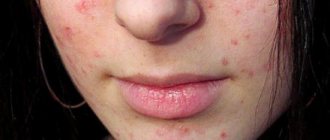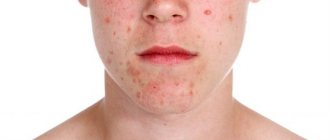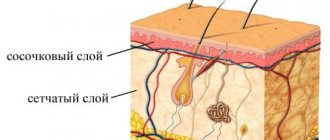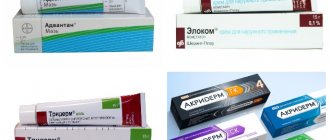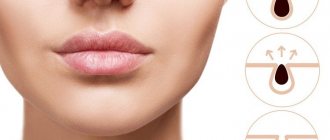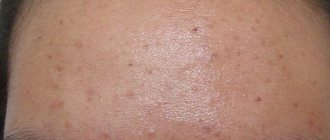Regenerating preparations for acne scars
Contratubex-gel
The drug contains onion extract and sodium heparin. Together with other substances, they help stop the formation of scar tissue and relieve inflammation. Contractubex helps fight young scars. The drug is often used in cosmetic procedures.
The gel should be used daily, 2 times every 12 hours for 2 months.
Scar Aesthetic
The cream contains vitamin A, onion extract, various antioxidants and natural stimulators of cellular renewal. For deep and old scars, cosmetologists recommend using the drug in combination with silicone stickers.
Apply the cream twice a day to dry skin. Time of use – 2-3 months.
Kelo-cote
The base of the substance is silicone. The gel forms a protective film on the surface of the scar. This allows you to protect it from the negative influences of the external environment and stop the growth of scar tissue.
At the same time, the gel has a strong moisturizing effect.
The drug should be applied twice a day to the scar area in a very thin layer. Course – 2-3 months.
Zeraderm
In addition to silicone, the gel contains coenzymes, anti-inflammatory and anti-allergenic components. Using a cotton swab, the gel should be applied to cleansed areas of skin with scars using massage movements twice within 24 hours.
The course of application is from 2 weeks to 6 months, depending on the condition of the scar.
Kelofibrase
The main component is urea . It softens scar tissue, brightens it and makes the skin more elastic. Camphor improves blood circulation and stops skin atrophy.
The drug should be applied 2-4 times during the day using massage movements. For serious scars, use compresses.
Fermenkol
The drug contains 9 collagenase components. When used regularly, they destroy the collagen and hyaluronic acid that form the scar. And then new skin fibers are formed from the resulting splitting materials.
For application to scars, the gel is used daily for 1 month.
Then he takes a break and the course is repeated.
Mederma
After acne on the face, it is necessary to quickly stop inflammation and the spread of scarring to healthy tissue. Mederma helps with the problem of how to get rid of scars and protect the skin.
Apply the cream daily (2-4) using pressing movements. The course can last from 3 to 6 months.
Liquid cream Skarguard
It contains silicone, vitamin E and hydrocortisone. Externally, the cream looks like a bottle of nail polish. The substance is applied to the scars using a brush.
You need to use liquid cream 2 times a day. The course is from one month to six months.
Cream Dermatix
The basis of the drug is polymeric organosilicon compounds. It is used to restore skin with fresh scars and scars. The cream can further reduce pain and itching at the site of skin damage.
The cream is applied 2 times a day (1 time using a bandage). The course is at least 2 months.
Piyasil
The active ingredient of the product is mink oil. These are processed subcutaneous tissues of an animal. They help cope with scars due to their high similarity to human fibers.
The drug must be applied at least 3 times a day.
What does scar removal mean?
Any method of removing scar changes must cause tissue remodeling. In some cases it is aimed at filling the hole, as with atrophic scars, and in others it is aimed at smoothing the tissue. It is important that the methods used are not only effective, but also safe.
How does a laser work on a scar?
An example of the low effectiveness of the procedure is the treatment of scars with hyaluronic acid preparations. There is no point in treating atrophic scars with hyaluronic acid, especially at the first stage. The filler does not regenerate the scar, but camouflages it, and not for long.
In modern aesthetic medicine there is also a shift away from dermabrasion and peeling. Bad peeling will be ineffective, and strong peeling will be dangerous.
It is also advisable to avoid methods that require a large number of procedures. Examples: microcentesis, non-ablative laser, picosecond laser, retinoids. These methods still somehow work with fresh scars, but the number of sessions in relation to the effects is inadequate.
Inexpensive pharmaceutical remedies for acne scars
Clearvin
In cosmetology, Clearvin is used to eliminate many facial skin imperfections: from age spots to acne scars. The drug contains substances that are used in Indian folk medicine: aloe vera, harad, turmeric, vacha, neem, etc.
The first results are noticed after 1 month, but you need to use the product for at least 2 months.
Sledotsid ointment
The product removes inflammation and restores normal skin color in places where scars form.
It is recommended to apply it several times a day until the scars lighten to the shade of healthy skin.
Balm Rescuer
The active ingredient of the drug is milk lipids. They form a protective film, moisturize and nourish the skin. Natural beeswax and sea buckthorn oil help soften rough tissues.
The balm is used to lubricate scars and to create compression packs.
Badyaga
To prepare the product, bodyagi powder and hydrogen peroxide are mixed. The consistency of the mask should resemble thick porridge. Apply the product to the skin for 5-7 minutes.
You can repeat the procedure no more than once a week, as the mask causes peeling of the skin. Course - 10 procedures.
Vishnevsky ointment (Balsamic Liniment)
The composition of the drug includes tar, castor oil and xeroform. They help regenerate tissue, reduce scar volume and protect the skin from the appearance of new acne.
The product is used to apply compresses. They need to be done every day.
Don't miss the most popular article in the section: Facial massage according to the system of the Japanese doctor Asahi Zogan.
Types of acne and acne scars
Much depends on the color or texture of the skin:
- Color. Scars may be red, skin-colored, or almost white.
- Structure. If we consider the structure of the skin, they can be convex or concave.
- Density. Scars can be of normal, high or low density.
- Depth. They can be shallow or deep.
- Peculiarities. With or without adhesions.
Types of Acne Scars
If we multiply the types of acne scars by the ways in which they can occur, we get dozens of different cases. If one more person had one type of scar, treating it wouldn't be as much of a problem as it would be if they had all of those types at the same time.
The most difficult scars to treat are white scars, as there are no effective treatments for discolored skin yet. There are also very complex cases when atrophic and raised scars are located nearby or there are deep scars.
Homemade masks for acne scars
Tea tree oil mask
One part of oil is mixed with 3 parts of boiled water. The composition is applied daily to scars. To prevent healthy tissue from being damaged by the oil, a cotton swab is used for application.
Clay mask
To create a mask, you need to mix cosmetic clay, water and lemon juice in a ratio of 2:2:1. The product is applied in a very dense layer to the entire surface of the skin.
The mask is washed off with a damp cotton pad after 25 minutes. The course consists of 12 procedures, which can be repeated after 3 days.
Tomato mask
Tomato juice contains a lot of antioxidants and vitamins, which have a positive effect on blood circulation in the skin and subcutaneous tissue. It is recommended to wipe your face with frozen tomato juice every day, and apply tomato puree for 20-30 minutes 2-3 times a week.
Protein-cucumber mask
The white should be beaten vigorously until foamy, and one medium cucumber, along with its peel, should be crushed to a puree. The protein-cucumber mixture is applied to the face for 15 minutes.
Fermented milk mask
Mix one part each of natural yogurt, chopped oatmeal and low-fat sour cream. Before applying to the face, add half of the lemon juice to the mixture. The mask should be washed off after 15 minutes.
It is enough to do this mask every other day for 1 month.
Pineapple mask
One medium pineapple is cut into pieces and then pureed in a blender. After this, the mass is applied to the face and lightly rubbed into problem areas. Vitamin C activates collagen production, and fruit acids soften scar tissue. You can make a mask no more than 1-2 times a week.
Homemade ointments against scars
Cabbage ointment
A few leaves of fresh cabbage are ground in a blender until pureed. Then you need to add a few tablespoons of any honey to the mixture. The consistency of the resulting product should resemble thick sour cream. Cabbage ointment is stored only in the refrigerator. You need to apply it to your face at least 2 times a day for 2 months.
Ointment with propolis
An equal amount of propolis and sea buckthorn oil must be mixed and melted in a water bath until the liquid becomes homogeneous. Then the ointment cools.
It is recommended to apply the product to the face several times a day, always in the morning and evening.
Nutmeg and milk ointment
2 tbsp. l of powdered nutmeg should be mixed with 7 tbsp. l. liquid honey and 2 tbsp. l full fat fresh milk. The ointment must be thoroughly mixed so that the components turn into a homogeneous mass. The ointment is applied daily (for 15-20 minutes) until the scars become less noticeable.
Onion ointment
To create onion ointment you will need one large onion, a pinch of salt and 2 tsp. l. grated baby soap. You need to add salt and soap to a glass of water, and then finely grate the onion. The mixture should be simmered for about 15 minutes over low heat and then passed through cheesecloth.
The ointment can be applied to problem areas 1-2 times a day. The course of treatment is 1.5-2 months (repeated if necessary).
Traditional recipes for scars and acne
Baking soda
Cosmetologists recommend using soda if new acne appears on the skin, as it is an excellent antiseptic.
To prepare the product, you need to dissolve a few tablespoons of soda in water. Then the substance is applied to the skin using massage movements. After 1 minute, the soda is washed off. It is recommended to use the product no more than 2 times every 7 days, as soda dries out the skin.
Rosehip oil
To get rid of shortcomings, it is recommended to conduct self-massage sessions with rosehip essential oil. Using a napkin, the substance must be applied to the damaged areas. After it has been absorbed a little, massage the skin with your fingertips and lightly massage the oil into the scar tissue. Procedures can be performed several times a day or once before bedtime.
Parsley
In the question of how to get rid of acne scars on the face, rubbing with parsley ice will help. To do this, you need to prepare a decoction: pour half a glass of finely chopped parsley with boiling water. After cooling, the solution is poured into ice cube trays and frozen.
You can use ice every day after washing your face in the morning until the scars become smaller.
Potassium permangantsovka
Potassium permanganate is a powerful oxidizing agent that is a home alternative to chemical peeling. To prepare the product, potassium permanganate must be dissolved in water until it turns purple. Then the solution is applied to the scars using a cotton swab, avoiding undamaged tissue.
It is recommended to apply potassium permanganate only to the hands or back, as it stains the skin. Course - 1-1.5 months 1-3 times every 8 days.
Hydrogen peroxide
Hydrogen peroxide softens and lightens scar tissue. This helps make acne scars less noticeable. A mixture of peroxide and baby powder helps provide a slight polishing effect. To do this, peroxide and powder are mixed 1 to 3.
The mixture should be applied to the face every day and left for 30 minutes. The course is more than 1 month.
Don't miss the most popular article in the section: Face fitness for facelift, rejuvenation, muscle tone. Master class from Elena Karkukli
Why do acne scars occur?
The method of getting rid of post-acne depends on how it is expressed:
- enlarged pores;
- spots of congestive hyperemia;
- telangiectasia, persistent erythema;
- scarring;
- post-inflammatory hyperpigmentation.
The reason for the appearance of scars is the occurrence of a destructive inflammatory process in the dermis. Keloid scars form less frequently than atrophic scars. The type of scar depends on the type of skin, the extent of the process, the intensity of the ongoing inflammation, the correctness of the therapy, the severity of the immune response, and other factors.
Scars are easier to treat than to correct. Only scars can be treated for up to a year. Many people are interested in how to remove acne quickly. But there is no way to quickly get rid of spots and scars caused by acne. This is always a long process.
Cosmetic and medical methods
Laser resurfacing
Laser resurfacing is a safe and painless method, but has a high cost. The laser beam cuts off the top layers of skin and smoothes out the scar.
In terms of methodology, this method is similar to dermabrasion, but is more gentle.
The session can take from half an hour to 1 hour depending on the size of the scar. Repeated procedures can be carried out only after complete healing of the skin.
Chemical peeling
Chemical peeling will help you decide how to get rid of acne scars on your face.
In a chemical peel, acids are used to attack the scar tissue. They soften scars, leaving the skin softer and smoother. It is quite difficult to completely get rid of scars in this way, but after softening the skin acquires a lighter shade of healthy tissue. The number of chemical peel sessions depends on the number of scars, skin type and condition.
Dermabrasion
Dermabrasion is one of the most effective procedures for getting rid of scars. During this procedure, the skin is “polished” using special devices – cutters. During dermabrasion, a person experiences severe pain, so it is performed only under local anesthesia.
If acne scars are very deep, they can be cut off with a scalpel first.
To completely get rid of scars, you may need from 3 to 7 procedures. They can only be carried out with a break of one month.
Mesotherapy
Mesotherapy will help you get rid of scars on your face.
Acne scars can be treated in this way using two options:
- injection administration of the drug;
- use of special masks.
The latter can only be used for minor skin lesions. In the second case, using special devices, thin punctures are made on the skin through which the drug is injected. It is able to change the structure of fibrous tissue and gradually destroy it.
In most cases, 10 procedures with short breaks are sufficient, the time of which is set by the cosmetologist. In case of serious damage to the skin and frequent appearance of scars, the course is carried out once a year.
Ozone therapy
Ozone therapy uses ozone, which is injected under the skin. The substance improves metabolism and accelerates the formation of new tissues. In addition, adipose tissue is broken down and the skin is smoothed.
As a means of getting rid of facial scars, ozone therapy is useful both after acne treatment and during the appearance of acne. The substance has a strong antiseptic effect. Depending on the size and density of the scars, from 5 to 15 ozone therapy procedures may be prescribed.
To successfully combat scars on the face after acne formation, cosmetologists recommend using a set of measures. To achieve a quick effect, pharmaceutical products must be combined with traditional medicine methods and cosmetic procedures. You should also remember about regular skin care, depending on its type and sensitivity.
How do scars appear on the face?
Acne or acne is a malfunction of the skin's sebaceous glands, which release excessive amounts of sebum onto the surface of the skin. This functioning of the sebaceous glands provokes the appearance of acne. When pimples are squeezed, the skin is injured and scars appear in areas where the skin is excessively damaged.
After acne goes away, the connective tissue, which is based on collagen, cannot always restore its structure, especially if the inflammation was severe. In this case, a scar appears at the site of the pimple, and the skin texture becomes uneven. You can effectively prevent scars by treating your acne.
If your skin suffers from breakouts, you can protect it from the consequences. Scars on the face may appear in the following cases:
- self-squeezing pimples;
- lack of hygiene;
- sensitive and thin skin;
- the inflammation was furunculous (purulent) in nature;
- infectious inflammation with subsequent infection of the lesion.
Independent mechanical cleansing of the face seriously injures the skin, which entails its uneven relief. If acne removal does occur at home, it is recommended to adhere to the following recommendations:
- The face must be steamed before the acne removal procedure;
- you can squeeze out blackheads and acne only with your fingers;
- After cleansing, the facial skin must be treated with an antiseptic.
It is quite difficult to remove post-acne scars without the help of specialists, but you can try folk remedies or consult a cosmetologist. To avoid scarring, do not squeeze out acne yourself. Hygiene rules must be carefully observed. You can remove traces of inflammation in beauty salons using special procedures. Treatment of acne scars requires patience and perseverance, but the use of modern procedures, medications or folk remedies will help solve the problem.
